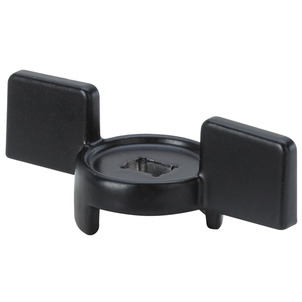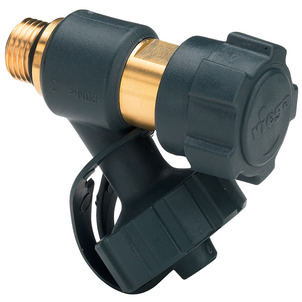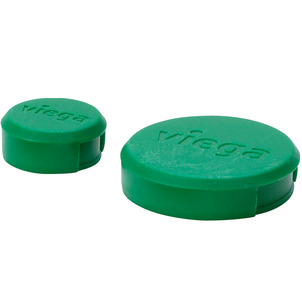Easytop ball valve
Product information

Easytop ball valve
| Year built (from): | 01.07.2017 |
Trade mark rights exist for this document; for further information, go to viega.com/legal .
Target groups
The information in this manual is directed at qualified heating and plumbing engineers and trained personnel.
Individuals without the abovementioned training or qualification are not permitted to mount, install and, if required, maintain this product. This restriction does not extend to possible operating instructions.
The installation of Viega products must take place in accordance with the general rules of engineering and the Viega instructions for use.
Labelling of notes
Warning and advisory texts are set aside from the remainder of the text and are labelled with the relevant pictographs.

DANGER!
This symbol warns of possible life-threatening injury.

WARNING!
This symbol warns of possible serious injury.

CAUTION!
This symbol warns of possible injury.

NOTICE!
This symbol warns of possible damage to property.

INFO!
This symbol gives additional information and hints.
About this translated version
This instruction for use contains important information about the choice of product or system, assembly and commissioning as well as intended use and, if required, maintenance measures. The information about the products, their properties and application technology are based on the current standards in Europe (e.g. EN) and/or in Germany (e.g. DIN/DVGW).
Some passages in the text may refer to technical codes in Europe/Germany. These should serve as recommendations in the absence of corresponding national regulations. The relevant national laws, standards, regulations, directives and other technical provisions take priority over the German/European directives specified in this manual: The information herein is not binding for other countries and regions; as said above, they should be understood as a recommendation.
Standards and regulations
The following standards and regulations apply to Germany / Europe and are provided as a support feature.
Regulations from section: Fields of application
Scope / Notice | Regulations applicable in Germany |
|---|---|
Planning, execution, operation and maintenance of potable water installations | DIN EN 806, part 1 |
Planning, execution, operation and maintenance of potable water installations | DIN EN 806, part 2 |
Planning, execution, operation and maintenance of potable water installations | DIN EN 806, part 3 |
Planning, execution, operation and maintenance of potable water installations | DIN EN 806, part 4 |
Planning, execution, operation and maintenance of potable water installations | DIN EN 806, part 5 |
Planning, execution, operation and maintenance of potable water installations | DIN EN 1717 |
Planning, execution, operation and maintenance of potable water installations | DIN 1988 |
Planning, execution, operation and maintenance of potable water installations | VDI/DVGW 6023 |
Planning, execution, operation and maintenance of potable water installations | Trinkwasserverordnung (TrinkwV) |
Regulations from section: Media
Scope / Notice | Regulations applicable in Germany |
|---|---|
Suitability for drinking water | Trinkwasserverordnung (TrinkwV) |
Suitability for heating water for pump hot water heating systems | VDI 2035 Page 1 and page 2 |
Regulations from section: Product description
Scope / Notice | Regulations applicable in Germany |
|---|---|
Suitability for potable water installations | Trinkwasserverordnung (TrinkwV) |
Suitability for potable water installations | DIN 50930‑6 |
Requirements in plastic components in potable water installations | DVGW-Arbeitsblatt W270 |
Regulations from section: Overview
Scope / Notice | Regulations applicable in Germany |
|---|---|
Compliance with the inspection requirements (fittings group I) | DIN EN 13828 |
Regulations from section: Marking on components
Scope / Notice | Regulations applicable in Germany |
|---|---|
Designation noise class I | DIN EN 13828 |
Regulations from section: Compatible components
Scope / Notice | Regulations applicable in Germany |
|---|---|
G-external threads | DIN EN ISO 228 |
Regulations from section: Technical data
Scope / Notice | Regulations applicable in Germany |
|---|---|
Scope | DIN EN 13828 |
Regulations from section: Corrosion
Scope / Notice | Regulations applicable in Germany |
|---|---|
External corrosion protection | DIN EN 806‑2 |
External corrosion protection | DIN 1988‑200 |
External corrosion protection | DKI-Informationsdruck i. 160 |
Regulations from section: Leakage test
Scope / Notice | Regulations applicable in Germany |
|---|---|
Leakage test for potable water installations | DIN EN 806, part 4 |
Leakage test for potable water installations | ZVSHK-Merkblatt |
Regulations from section: Maintenance
Scope / Notice | Regulations applicable in Germany |
|---|---|
Operation and maintenance of potable water installations | DIN EN 806‑5 |
Intended use

INFO!
Coordinate the use of the model for areas of use and media other than those described with the Viega Service Center.
A ball valve is a fitting that is able to shut-off and open individual pipeline sections through a 90° movement. The ball valve is not a control fitting and cannot be used for regulating volume flows. The ball must not be in an intermediate position.

NOTICE!
Opening and closing the ball valve quickly can cause pressure shocks in the system.
Always open and close the ball valve slowly.
Areas of use
Use is possible in the following areas among others:
Potable water installations
Industrial and heating systems
Compressed air systems
Rainwater systems
Cooling water pipelines (closed circuit)
Systems for technical gases (on request)
The general rules of engineering and the applicable regulations must be observed for planning, execution, operation and maintenance of potable water installations, see Regulations from section: Fields of application .
Media
The model is also suitable for the following media, amongst others:
Potable water without limitations acc. to the applicable directives, see Regulations from section: Media
maximum chloride concentration 250 mg/l pursuant to applicable regulations, see Regulations from section: Media
Heating water for pump hot water heating systems, see Regulations from section: Media
Compressed air in compliance with the specification of the sealing elements being used
EPDM at oil concentration < 25 mg/m3
Product description
According to the applicable regulations, Easytop system fittings can be used for all types of potable water and are DVGW certified, see Regulations from section: Product description . Their plastic components comply with the KTW recommendation and the requirements pursuant to the applicable regulations.
Overview

INFO!
The Easytop system fittings comply with the test requirements specified in the applicable regulations, see Regulations from section: Overview . Sound protection Lap≤ 20 dB(A)
The model is equipped as follows:
valve casing made of gunmetal/silicon bronze
dual-sided G external thread
T-shaped actuating lever made of plastic
protective caps for the actuating lever in the red and green for the identification of the corresponding area of use
position indication open/closed
key surface on the casing
maintenance-free selector shaft
ball seal made of Teflon®
stainless steel ball
on both sides, drain plugs G ¼ with drainage valve G ¼
DN |
|---|
G |
15 | 20 | 25 | 32 | 40 | 50 |
¾ | 1 | 1¼ | 1½ | 1¾ | 2⅜ |
Threaded connection
Only flat sealing connection screw fittings may be used for the threaded connection.
Markings on components
The model is marked as follows:
noise class I pursuant to applicable regulations, see Regulations from section: Marking on components
Dimension
DVGW writing
Position indicator on the actuating lever
Compatible components
The model is equipped with G-external threads according to the applicable regulations and compatible with the Prestabo, Profipress, Sanpress, and Sanpress Inox system, see Regulations from section: Compatible components .
Technical data
Observe the following operating conditions for the installation of the model:
Operating temperature [Tmax] |
|---|
Operating pressure [Pmax] |
110 °C |
1.6 MPa (16 bar) |
Scope according to applicable regulations, see Regulations from section: Technical data
Operating temperature: 90 °C
Operating pressure: PN 10 (10 bar)
Information for use
Corrosion
Overground pipelines and fittings in rooms do not normally require external corrosion protection.
There are exceptions in the following cases:
Contact with aggressive building materials such as nitrite or materials containing ammonium
In aggressive surroundings
If external corrosion protection is required, observe the pertinent guidelines, see Regulations from section: Corrosion .

INFO!
Easytop fittings made of gunmetal/silicon bronze are suitable for all types of potable water.
The chloride concentration in the medium must not exceed a maximum value of 250 mg/l.
This chloride is not a disinfectant, but in fact pertains to the content in sea and table salt (sodium chloride).
Optional accessories
The following optional accessories are available:
actuating lever made of metal
Easytop thermometer
Easytop media marking
Easytop extension
Easytop drainage valve
Protective caps for the actuating lever made of plastic in red and green for the identification of the corresponding area of use
Insulating shells







Insulating shells
EPS insulating shells are available for all sizes of ball valves. The two-piece shells are self-supporting and are mounted without tools and holding grips. They connect seamlessly to the front surfaces of the pipeline insulation.

Handling
Assembly information
Mounting instructions
Checking system components

INFO!
Do not remove the model from the packaging until immediately before use.
System components may, in some cases, become damaged through transportation and storage.
Check all parts.
Replace damaged components.
Do not repair damaged components.
Contaminated components may not be installed.
During assembly
Observe the following when mounting:
Use suitable tools.
Installation is not dependent on the direction of flow.
When tightening the connection screw fitting, counter by holding the key surface of the valve.

INFO!
Choose the place of installation so that the fitting is easily accessible, simple to operate and the insulating shell can be mounted without any problems.
Laying and fixing pipes
For information, refer to the instructions for use of the Prestabo, Profipress, Sanpress and Sanpress Inox systems.
Laying and fixing pipes
For information, refer to the instructions for use of the Viega system of the product you are using.
Length expansion
For information, refer to the instructions for use of the Prestabo, Profipress, Sanpress, and Sanpress Inox systems.
Length expansion
For information, refer to the instructions for use of the Viega system of the product you are using.
Assembly
Leakage test
The installer must perform a leakage test before commissioning.
Carry out this test on a system that is finished but not covered yet.
Comply with the general rules of engineering and the applicable directives, see Regulations from section: Leakage test .
Perform leakage test should in acc. with the general rules of engineering for non-potable water installations.
Document the result.
Maintenance

NOTICE!
Inform your customer or the operator of the potable water installation that the system has to be maintained on a regular basis.
Observe the applicable regulations for the operation and maintenance of potable water installations, see Regulations from section: Maintenance .

INFO!
Viega recommends actuating the fitting regularly and checking its function.
Disposal
Separate the product and packaging materials (e. g. paper, metal, plastic or non-ferrous metals) and dispose of in accordance with valid national legal requirements.